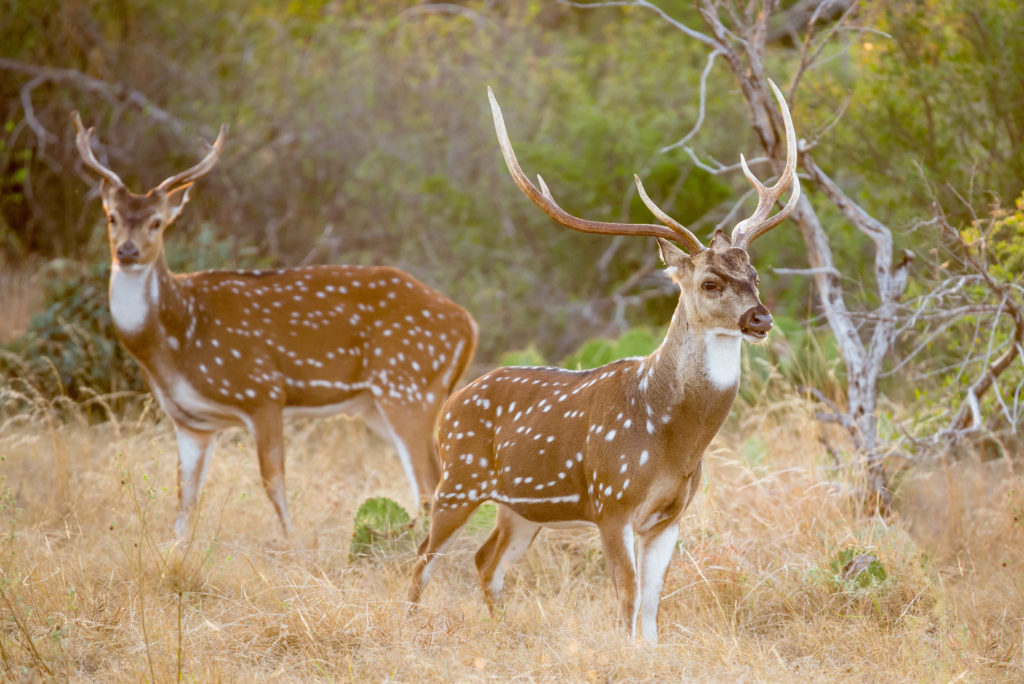
Axis Deer in Texas – The Ultimate Guide!
You’ve come to the right place to learn about Axis Deer! I’ve scoured the internet, spoken with several Texas breeders, and reviewed dozens of scholarly publications to give you the best article on Axis Deer in Texas available. It’s designed so you can skim straight to the topic you want to learn about or dive in and learn everything you can. I also give credit where it’s due, check out the incredible resources and citations at the bottom of the article. Enjoy!
Article outline:
- Axis Deer Origin
- Axis Deer in Texas
- Axis Deer Diet in Texas
- Axis Deer Habits
- Axis Deer Reproduction
- Axis Deer in Competition with White-tailed Deer in Texas
- Axis Hunting In Texas
- Buying Live Axis Deer in Texas
- Axis Deer Meat
- About The Author – Michael Morrow
- Resources & Citations
Axis Deer Origin
Axis deer are originally from India and Sri Lanka where they are referred to as Chital or spotted deer. The deer are thought by many to be the most beautiful deer as their coats are rust colored and covered with white spots, very similar to a White-tail fawn. They are a sizable Cervid species with Axis does weighing in from 110-135lbs while bucks can weight in at up to 200lbs.
Their native habitat ranges from the foothills of the Himalayas and stretches southward to the sub-tropical forests along the Southern tip of India, indicating a wide tolerance for habitat suitability.
On a side note, they are a well noted prey of the Bengal Tiger…..

Their first introduction to the United States was actually in Hawaii where they were imported in the 1860’s as a gift to the Hawaiian King from Hong Kong. The deer now inhabit several of the Hawaiian Islands including Hawaii, Lanai, and Maui as a feral species.
Axis Deer in Texas
Axis have been roaming in Texas since the 1932 when they were brought in as a game species in South Texas. Over several decades these deer were transported throughout Texas as other private ranchers wanted to include them on their property as a year-round hunting option. In time, many Axis escaped and eventually created feral populations.
Axis Deer Range in Texas
In 1988 they were noted as having self-sustaining populations in 27 counties within Central and South Texas. They have since expanded into 92 Counties and have a current estimated population of up to 125,000 animals according to Exotic Wildlife Association. The highest populations of Axis Deer in Texas are now centered around the Edwards Plateau.
This is also the are of the State with the highest populations of White-tailed Deer, click this link for a break down of White-tailed Deer Populations in the State of Texas.
White-tailed Deer populations are well documented; however, for the purposes of writing this article, I found it surprisingly difficult to find any data documenting the spread of Axis deer over time or any recent scientific data that would indicate an accurate population estimate.
There are several high quality institutions that offer anecdotal references to Axis populations. For example, according to Texas Tech University, Axis deer are now the most abundant exotic ungulate in Texas.
If you are aware of any studies or resources that show better population data please reach out to me and I’ll gladly update this portion of the article.
Anyone driving through the Texas Hill Country can believe in their abundance. Although Axis are still no where near as common as White-tailed deer overall, it is still a common occurrence to see them crossing roads and grazing/browsing along tree lines.
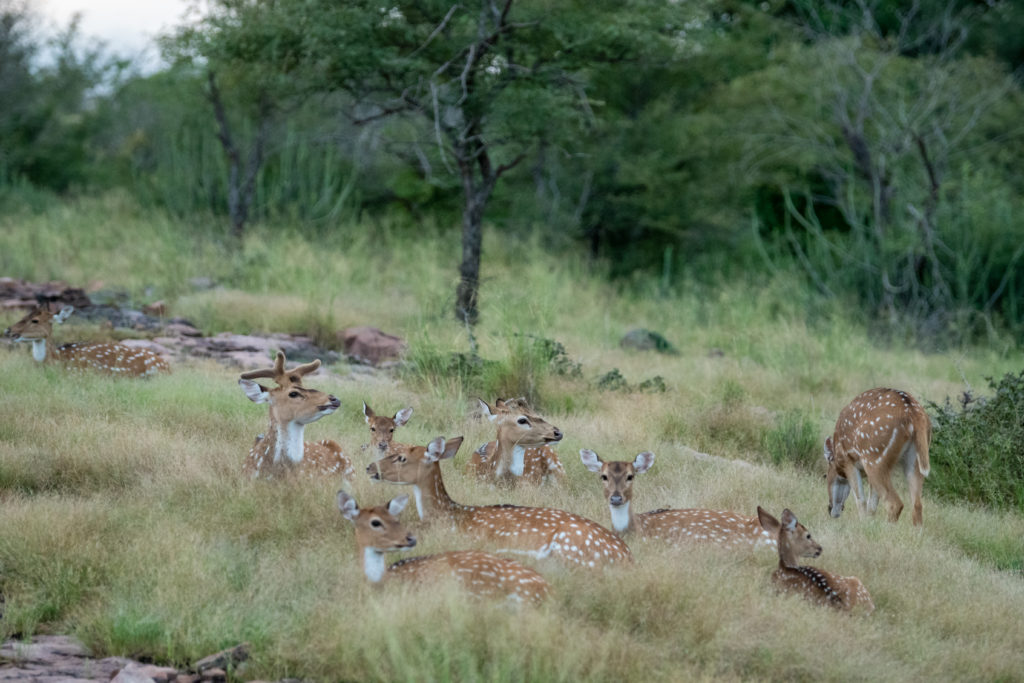
The Texas Hill Country and Edwards Plateau host a similar (albeit slightly cooler) climate as their native habitat and provide a similar combination of cover. The area also provides ample nutrition through grasses, forbs, and browse. This combination, along with their continued introduction into new areas by ranch stocking has created a perfect scenario for a rise in population.
Axis Diet in Texas
Axis Deer are grazers and focus on eating a broad variety of food; including grass, forbs, and browse. This is in contrast to White-tailed Deer who are much more selective, eating predominantly forbs and browse.
To learn more about what White-tail eat, I have another article that goes much more in depth about White-Tailed Diets in Texas here.
Axis seem to prefer short green grasses but will dine on Little Bluestem, Indian Grass, SwithGrass, paspalums, and gramas. They also appear to eat many sedges during the spring (Axis Deer: Texas Tech University).
A study conducted by (Henke et al. 1988) titled Digestive Capacity and Diets of White-Tailed Deer and Exotic Ruminants, harvested 20 Axis Deer and studied the contents of their rumen. They discovered that Axis, Fallow, and Blackbuck Antelope consumed greater than 93% Grass on the Edwards Plateau.
Axis Deer Habits
Axis deer are more active by day than by night. Their activity seems to peak in the couple of hours post dawn and pre-dusk. They tend to avoid rugged areas and spend most time congregating on flatter terrain.
According to Ernest Ables, Author of “Axis Deer in Texas, 1977” the basic family group consists of an older doe and her offspring. Herds can consist of several family groups and can range in size from just a few animals to well over 100.
Axis social behavior is much more like Elk than White-tail. Adult and young males will actively participate in the social structure of the herd. Axis bucks will also bugle and bellow similar to Elk while in rut, and both sexes will bark when alarmed (Axis Deer: Texas Tech University).
Their home ranges average 2 1/2 square miles (1,560 acres) in the coastal live oak regions of Texas (Axis Deer: By Ernest Ables). White-tailed bucks in the same region have home ranges of 1,400-3,300 acres and White-tailed does in the region exhibit home ranges of 370-900 acres, depending on time of year (Fulbright & Ortega, White-tailed Deer Habitat 2006).
Axis Deer Reproduction
Axis deer reproduce year round but most breeding occurs in early summer (May-July) resulting in predominately single fawn births the following spring. They reproduce consistently, most hunters find it rare to harvest an Axis doe who is not pregnant or nursing. Does have a 7 1/2 month gestation period and have been known to produce 4 offspring in 3 years.
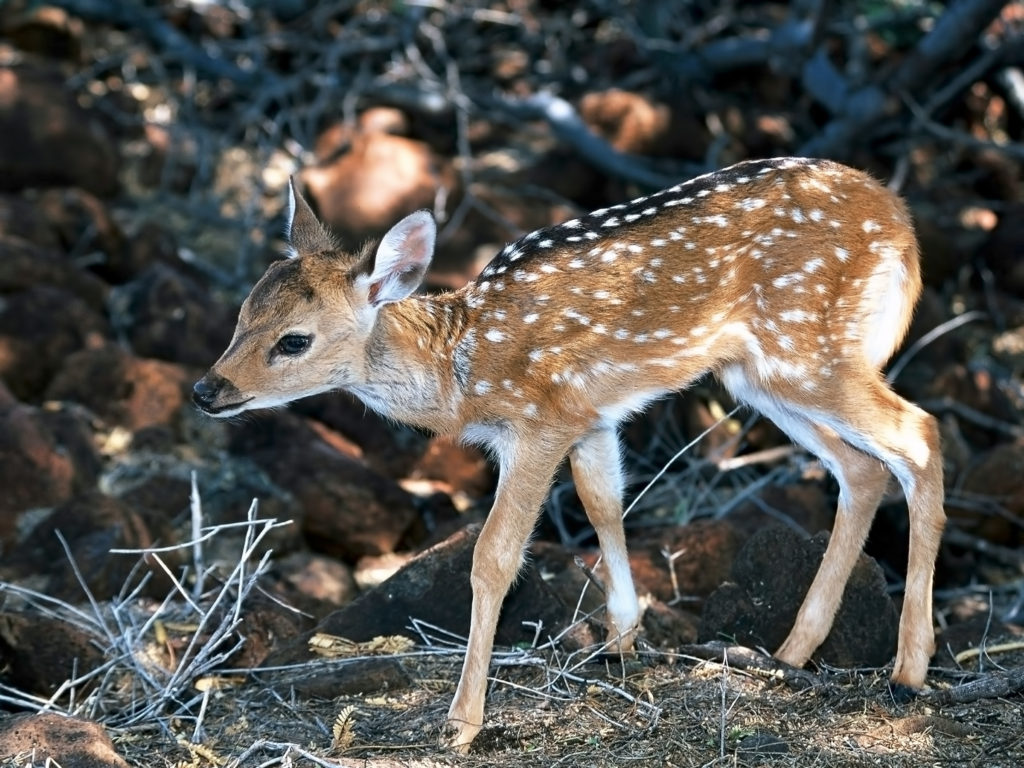
There is no general consistency to which time of the year bucks maintain and shed their antlers. Bucks with hard antlers can be found year round even in the same herd. Each buck will maintain it’s own reproductive cycle and will come into rut after it’s antlers are hard. Does too, have their own reproductive cycle and it’s common for a herd to have multiple does in estrus at any time of year.
In a herd, it’s common to have bucks come into rut as others are going out and to have does entering estrus as other does are finishing. This results in an ongoing production of fawns from the herd.
According to a study by Texas Tech University, 80% of fawns are born between January and Mid-April (Axis Deer: Texas Tech University) .
Axis Deer in Competition with White-Tailed Deer
There are some areas in the Hill Country where Axis do appear to outnumber White-tailed deer.
A recent article posted by HillCountryAlliance.org mentions that the Cave Creek Wildlife Management Association, a WMA located in Eastern Gillespie county, conducted surveys and counted 347 White-tailed deer and 546 Axis. This census indicates an issue that many biologists and landowners have feared, that Axis can and will out-compete our beloved White-Tailed Deer. View the article here.
Axis deer certainly compete with White-Tailed Deer as they co-exist in Texas. Although, it’s not a physical competition, it is a competition for resources.
Axis deer have similar diets to many other exotic ungulates brought into Texas; including Fallow, Sika, Blackbuck, and Aoudad. As mentioned above, their diets consist of combination of Forbs, Browse, and Grasses. All of these exotic ungulate species eat the same plants that the White-Tailed Deer eat but unlike White-tail they can digest grasses much more efficiently.
Click on this link to check out my comprehensive article on White-Tailed Deer Diets.
Exotics apparently can shift to a diet of grasses when preferred browse and forbs are stresssed by nutritional deficiencies associated with grass consumption (Baccus et al. 1985)
So, they eat the same plants as white tail, now it comes down to a simple math equation on how many grazers the land can support. Land can only produce a given quantity of vegetation to support grazers. The quantity of grazers land can support based on vegetation production is called it’s Carrying Capacity. It’s a zero-sum game, the more Axis (or other species) that are consuming vegetation, the fewer available resources there are available to other species such as the White-tailed deer.
How Axis Compete with White-tailed Deer
Texas Parks and Wildlife decided to study what would happen over time with White-Tailed Deer completing with Axis and other exotics. To do this they created six 96-acre pastures which were enclosed with deer proof high fence. All grazers were removed from each pasture and each pasture was then stocked with 6 White-Tailed Deer and 6 individuals of another species. In other words, Pen 1 would have 6 White-tail and 6 Axis, Pen 2 would have 6 White-tail and 6 Sika, etc. Click Here To Check it Out
Since this is an article about Axis let’s look at the results from that pen. The study ran for 8 years and had alerting results.
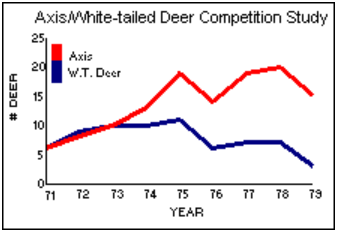
Initially both populations increased during the first 4 years of the study, indicating that the carrying capacity of the 96-acre plot was higher than 2 animal units (assuming 6 deer per animal unit). Between 1975 and 1976 the populations both levelled off, with the Axis maintaining a steady population and the White-tail showing a consistent decline. Bottom line, after 8 years there were only 3 White-tailed deer in the pen along with 16 Axis.
As a bonus, check out what happened in the pen stocked with 6 White-tail and 6 Sika.
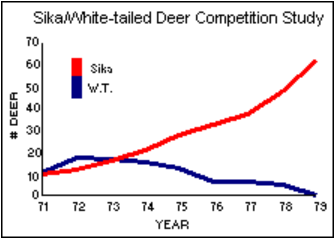
So why did this happen?
If they both eat the same items (Grass, Forbs, and Browse) why is it the Axis and Sika came out on top on both studies? The answer is simple (especially if you read my article about White-Tail Diets, hint hint), although White-tail will eat grass they are not efficient in digesting grasses.
It’s famously stated that a White-Tailed Deer will die of starvation with a belly full of grass. For this reason, Whitetail can only live on two classes of forage, forbs and browse.
Axis deer and their exotic ungulate counter parts also love to consume forbs and browse; however, when those two options are not available, they can readily consume and digest grass. So, there you have it, Axis deer have a clear dietary advantage to White-Tailed Deer and when resources become scarce (in times of drought OR an overpopulated high fenced area) it will be the Axis who prevail.
This does not mean that Axis will soon populate the Hill Country replacing White-Tail all together, but it does help explain the rise in population and it puts perspective on the Cave Creek WMA’s census results.
Axis Hunting in Texas
I would claim that Axis Deer are the most popular exotic ungulate to hunt in Texas. In fact, I may argue that they are second only to Feral Hogs as a non-game species hunting target. Then again, there are 2.6 Million Feral Hogs in Texas v.s. roughly 125,000 Axis and 3.6 Million White-Tail.
For more information on Feral Hogs and how they compete with White-Tail, check out our article Feral hogs: A whitetail’s predator and competitor.
As mentioned above, Axis deer have been hunted in Texas for almost 90 years. The meat is widely revered as the top game meat (more on this below), their hides are beautiful, and their antlers can have lengths of over 3ft. This combination along with their wide availability has led to a large interest for Axis hunts.
Since Axis deer are not indigenous to Texas, they do not have a season and may be hunted year-round. They are considered livestock along with cattle, sheep, goats, and the dozens of other exotic species brought into the State.
Officially Texas Parks and Wildlife has this to say about Axis Hunting in Texas.
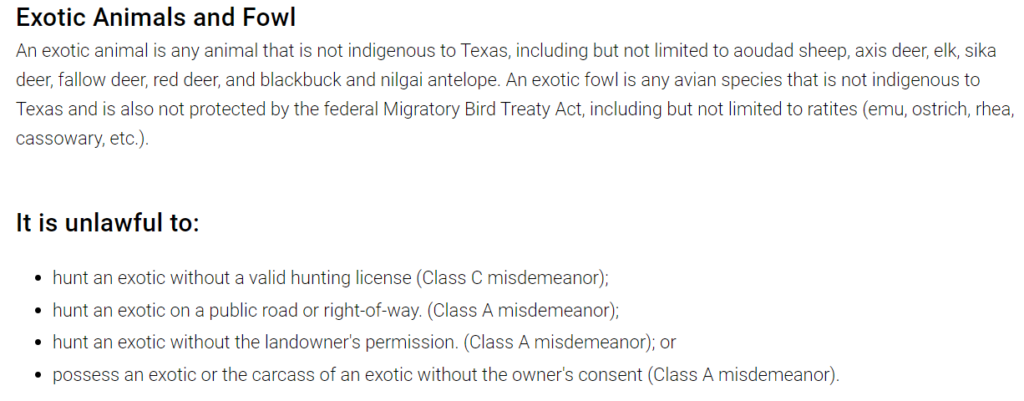
Having Axis and other exotics on a commercial hunting ranch provides a more stable income for the operations, who generally have a feverish October-February as hunters go after Whitetails.
Hunting Axis in Texas works a couple of different ways.
Landowners in the Texas Hill Country and surrounding areas may be fortunate enough to find feral populations roaming their property. In this instance an opportunity for harvest may present itself to the landowner or people invited to hunt on the private property.
For most hunters however, their only option is to travel to a commercial hunting operation and pay to hunt.
How much does it cost to Hunt Axis in Texas?
It costs between $1,750 and $5,500 to hunt an Axis Buck and between $350 and $800 to hunt an Axis Doe. Some ranches will include 2 nights lodging and an Axis doe after paying the price for a buck. Other lodges will charge a daily rate in addition to the fee for the animal. Fees for lodging range from $200/day to $600/day depending on the type of facility. These charges typically include the lodging, 3 hot meals/day (I’ve enjoyed my favorite meals at these ranches), as well as any alcohol.
Be aware that many of the nicer or more “exclusive” ranches/lodges will charge much more for the same size buck. For example, I’ve seen a 32” (decent size) buck range from $2200 to $3750 depending on what ranch you hunt them.
Pricing variability depends on the buck’s size and on the accommodations provided by the ranch. Most Axis advertised in pricing above are between 30-32”, and by any stretch they are good deer. Trophies/Record Axis are advertised at a premium generally from $4,200+ and are over 35”. Many will have drop tines or 8+ points. The current record Axis is noted as being from India and had lengths of over 41”.
Buying Live Axis Deer in Texas
If you own property and you’re looking to purchase live Axis Deer for stocking purposes you have several options. You can purchase the deer at an exotic livestock auction, go to a trapper, or go to an existing game ranch for stock.
Purchasing Axis at Texas Exotic Livestock Auctions
Exotic livestock auctions can feature many species of exotic deer, sheep, goats, zebras, birds, and cattle. They’re often a place to check on pricing and a great place to meet other ranchers doing the same thing you are.
Ranchers will bring their stock to the auction on consignment and the auctioneer will sell them off one lot at a time.
I recently attended an auction and saw Axis does going in lots of 4-8 running between $300 to $450/Doe, young bucks and spikes running between $200 to $450/Buck, and nice size bucks in velvet running between $1,100 to $1,800/Buck.
My only word of caution at purchasing stock through an auction is it is a stressful time for the animals. Axis are extremely susceptible to White-Muscle Disease and when stressed can become immobile, this can be fatal to the animal. Animals at an auction have to be moved twice (to and from the auction). Additionally, the animals must be moved around while at the auction.
Buying Live Axis Through a Trapper
Purchasing Axis through a trapper will give you flexibility on where target your animals. Often the trapper will know which ranches have the type of stock you’re looking for and will work with you on where to purchase your animals. The trapper will often require a markup on pricing of animals in addition to charging for capture and transportation.
Buying Live Axis Directly from a Game Ranch
You can also go straight to an existing game ranch and ask about purchasing livestock from them directly. Most ranches are happy to accommodate and will have relationships with trappers and transporters directly.
Axis Deer Meat
Axis meat is lean and widely noted has being the least “gamey” tasting of all deer. I can personally tell you that I prefer the taste of Axis to Whitetail or any other game species.
Venison.com reports that Axis deer meat was judged as the best tasting wild game meat by the Exotic Wildlife Association and that it contains less than 1% fat. It can be produced and marketed as fat free. At times, ranches can harvest several animals at a time and have a USDA certified mobile meat processor come out and process the animals onsite. The website also reports that mobile harvesters can haul up to 38 animals so that is the harvest goal once a trailer is brought to the ranch. I would recommend you check out their article about Axis and their production here.
In Closing:
I hope you enjoyed this article about Axis Deer in Texas. This article is just one of many where I commit to educating Texas Landowners and making the general public more knowledgeable about land in Texas. Please take the time to look through some of the other articles on the site and share with anyone who would enjoy the same information. If you’d like to learn even more about Axis Deer check out the resources I’ve provided below.
About the Author:
Michael Morrow is the founder of the Texas Landowner’s Association and a land agent in the state of Texas. He is dedicated to ensuring landowners have the resources, information, and platform they need to effectively accomplish their personal goals for their property. His undergraduate and graduate level studies at Texas A&M were focused around Rangeland Ecology and Wildlife Management. He’d love to help you with your next purchase or help take your property to market. You can reach him here by emailing Michael@LandAssociation.org
Resources & Literature Cited
Several conservationists, wildlife experts, scientists, ranches, and breeders contributed to the information in this article. Check out their contributions below:
- Axis Deer: By Ernest Ables
- Axis Deer: North American Deer Farmers Association
- Axis Deer: Texas Invasive Species Institute
- Axis Deer Population Control in Texas – Hill Country Alliance
- Dietary overlap among axis, fallow, sika, and white-tailed deer in the edwards plateau region of Texas, JAMES J. JACKLEY, Master’s Thesis, Texas Tech University
- Digestive Capacity and Diets of White-Tailed Deer and Exotic Ruminants, Scott E. Henke, Stephen Demarais and James A. Pfister , The Journal of Wildlife ManagementVol. 52, No. 4 (Oct., 1988), pp. 595-598
- An Economic Assessment of Axis Deer (Axis axis) farming in South Texas, Thesis by: Gregory Wayne Smith, Texas A&M University Kingsville, 1996
- Exotics in Texas (Max Traweek and Roy Welch)- Texas Parks & Wildlife
- Formal Paper About Axis Deer, Compiled By Comanche Spring Ranch, Eden Texas
- Habitat Interference by Axis Deer on White‐Tailed Deer, CLINTON J. FAASFLOYD W. WECKERLY, Journal of Wildlife Management, 13 December 2010
- The Status of Exotic Big Game in Texas, Gregory L. Butts , Rangelands 1(4), August 1979
- What You May Not Know About the Axis Deer- Exotic Wildlife Association
- White-tailed Deer v.s. Exotics – Texas Parks and Wildlife
- White-tailed Deer Habitat: Ecology & Management on Rangelands (Fulbright & Ortega)
